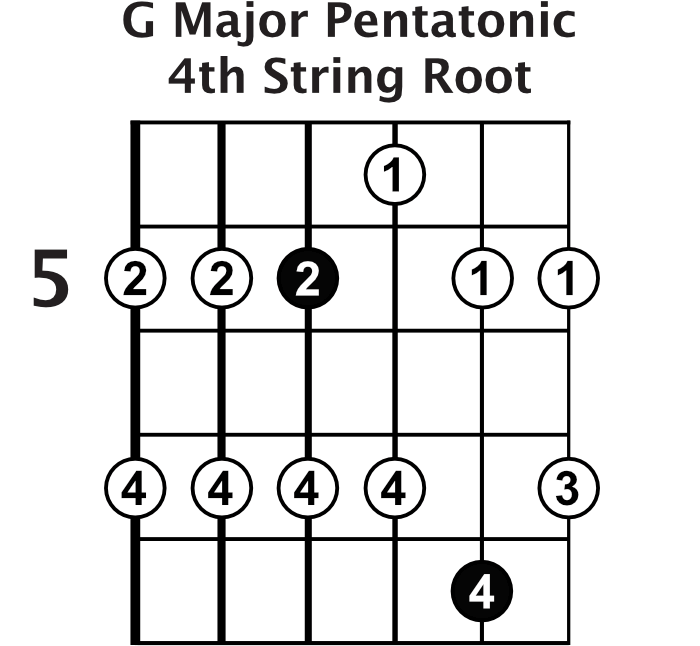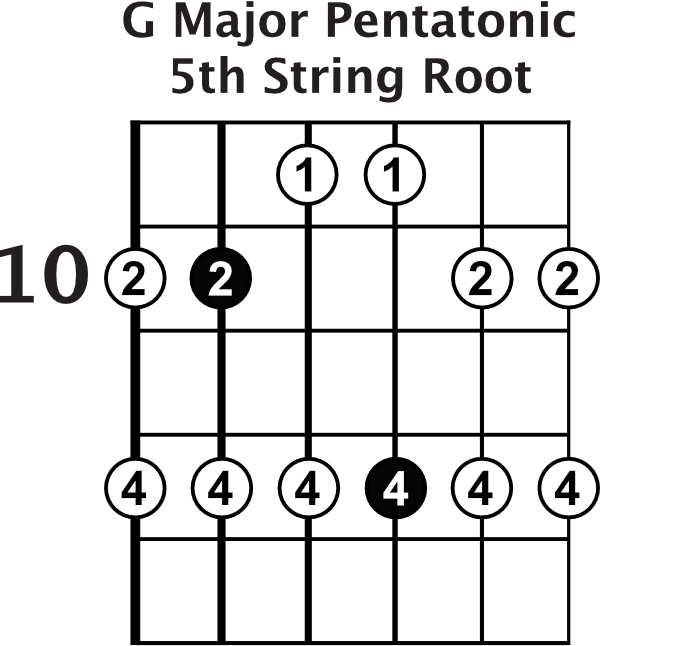Welcome to the twelfth lesson of the Lead Guitar Quick-Start Series. In this lesson, we’ll be covering the other major pentatonic shapes that you can use in your guitar solos. These shapes will help you to have more freedom to move around the fretboard when playing lead guitar.
Don’t feel like you need to use all these shapes in your lead guitar playing. It’s a lot better to have one or two of the shapes down really well rather than just using all the shapes for the sake of using them. This lesson is like a bonus lesson for the Lead Guitar Quick-Start Series, so feel free to take just one of these shapes, get to it well over time, and come back later to learn a new one.
Let’s start with the G major pentatonic scale with a fourth string root, using your second finger as the starting point. The lowest root note is the fifth fret on the D string, which is your anchor point. Play that note, and then play the seventh fret with your pinky. On the G string, hit the fourth fret with your index finger, and the seventh fret with your pinky. Your index finger with grab the fifth fret and your pinky will grab the eighth fret on the B string. For the high E string, it’s the fifth fret with your index finger and the seventh fret with your third finger.

To add in the lower notes to this scale shape, on the A string, play the fifth fret with your second finger, seventh fret with your pinky, and then do the same for the low E since it’s the same two note pattern. Just remember that your root notes are the fifth fret of the D string and the eighth fret of the B string.
Now we’ll move onto the next shape. The G major pentatonic with a fifth string root starting with your fourth finger, begins with the lowest root note on the tenth fret of the A string. From the root note, both the D and G strings have notes on the seventh fret with your first finger and ninth fret with your third finger. The B string has notes on the eighth and tenth frets with your second and fourth fingers. The high E string finishes the scale with notes on the seventh and tenth frets that you’ll play with your first and fourth fingers.

If you want to play the lower notes in this shape, there is one other note on the A string which is the seventh fret with your first finger, and two notes on the E string, the seventh and tenth frets with your first and fourth fingers.
The next scale up actually starts on the same root note, the 10th fret of the A string, but starts with your middle finger there instead of your pinky. That’s your lowest root note, and from there play the 12th fret with your pinky. On the D and G string, you’ve got the ninth and 12th frets to hit with your first and fourth fingers. The B and high E string also share a pattern, so you’ll play the tenth and 12th frets with your second and fourth fingers.

There are only two notes here lower than the root note, which are the tenth and 12th frets with your second and fourth fingers.
You should already know the shape of the last major pentatonic scale, but we’re going to look at it in a slightly different way. If you started this shape on an E root note on the 12th fret, it would be an E minor pentatonic scale, but if you use the G root note on the 15th fret using your pinky instead, it becomes a major pentatonic scale shape. Play this scale the same way as a minor pentatonic shape, but starting with the G root note instead and you’ll have this G major pentatonic, sixth string root scale down.

Even if you don’t have all of these scale shapes down you can feel free to move onto the next lesson. In the next video, we’ll talk about your next steps for lead guitar.
Are you looking for more lead guitar lessons and relevant jam-tracks? Guitareo is Nate Savage’s step-by-step video training system. It has some great songs for lead guitar and it also covers many other important styles of music including rock, country, fingerstyle, metal, classical, bluegrass, jazz, and more. Best of all it includes a huge library of original jam-tracks so you can apply everything to music.